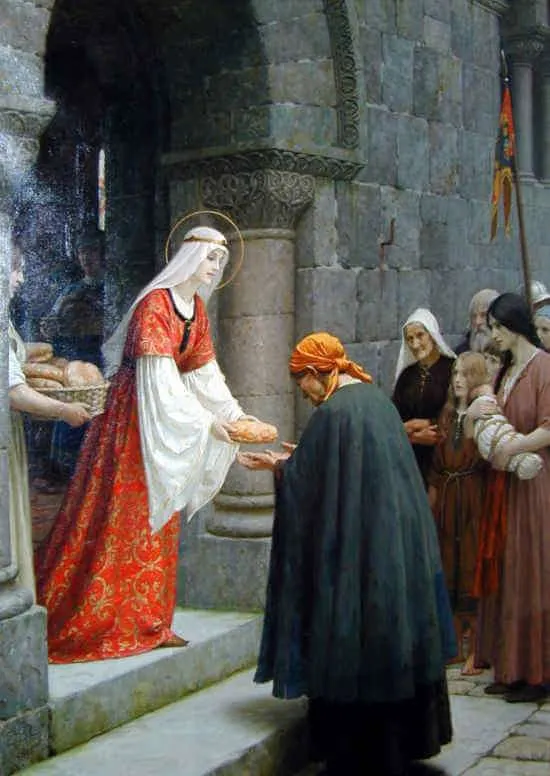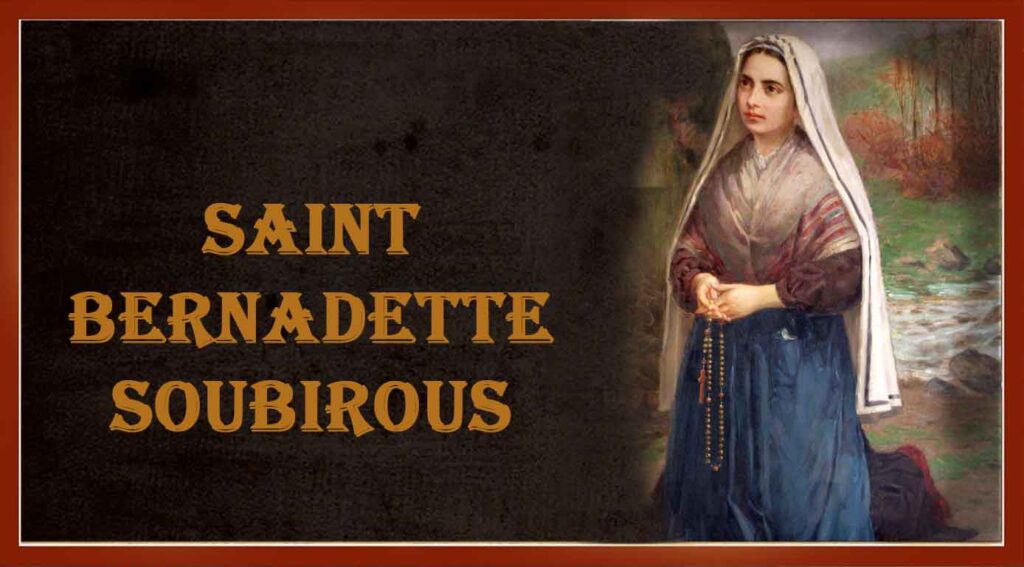1207–1231; Patron Saint of Third Order Franciscans, bakers, beggars, brides, charitable societies and workers, exiles, falsely accused people, homeless people, hospitals, lacemakers, nursing homes, nursing services, people ridiculed for their piety, widows; Invoked against in-law problems, the death of children, and toothache; Canonized by Pope Gregory IX on May 27, 1235
Elizabeth was born to King Andrew II and Queen Gertrude of Hungary. Her aunt on her mother’s side was Saint Hedwig, Duchess of Silesia. As was the common practice at that time for nobility, marriages were arranged at an early age to secure alliances between powerful ruling families. When Elizabeth was only four, knights arrived to take her to Thuringia, about five hundred miles away, where she was brought up in the court of Hermann I, Landgrave (ruler) of Thuringia. Her upbringing was alongside Hermann I’s eleven-year-old son, Louis IV, to whom Elizabeth was betrothed in marriage, which took place ten years later. Elizabeth’s mother was from the powerful House of Andechs and had similarly married King Andrew for political reasons. Because Queen Gertrude was not from Hungary, she was queen consort, meaning she was queen by virtue of marriage, not enjoying direct authority in Hungary on account of her royal lineage. Nonetheless, Gertrude regularly exerted her influence within Hungary’s royal court, causing conflict among the nobles and royal family. As a result, Queen Gertrude was assassinated when her daughter, Elizabeth, was six years old.
Two years before, a large entourage and dowry from her father had accompanied Elizabeth to the court of the Landgrave of Thuringia. There, she received a Catholic upbringing, an excellent education, and was cared for by attendants (ladies-in-waiting). She learned culture, manners, and royal protocol; attended banquets; wore fine clothing; and witnessed the intrigue and power struggles common in the royal court. The Castle of Wartburg in which she lived was a magnificent castle, and the Landgrave of Thuringia one of the richest in the empire. Life was extravagant, with poets and musicians, fine meals and social gatherings, and the best of what the world at that time had to offer. Behind the scenes, many factions plotted and formed alliances, seeking power and favors. Despite the challenges and worldly temptations she was thrust into at such a young age, Elizabeth grew in faith. She prayed, practiced mortification, and fell deeply in love with her Lord.
During the first ten years in Wartburg Castle, Elizabeth and her future husband, Louis IV, were raised together and formed a deep personal and spiritual bond. Though the marriage was arranged, they put their minds, hearts, and wills into what would soon become their future together. Louis’ father died when he was sixteen years old, and Louis became the Landgrave of Thuringia. Four years later, Elizabeth and Louis were wed.
From the very beginning, Elizabeth did not fit in with the courtly life. She was sensitive to the poor, sought virtue, and preferred simplicity, which made her an object of gossip and slander among the more “refined” members of the court. In Louis, however, she found a strong support. He admired her virtues and goodness and dismissed any criticism that came to his ears, defending her before all.
About two years after their marriage, when Elizabeth was sixteen, Franciscan friars arrived at the castle to care for the spiritual needs of the royal court. The holy Friar Conrad of Marburg became Elizabeth’s spiritual director. Through him, she learned about the saintly life of Saint Francis who probed the highest heights of holiness, even being pierced with the stigmata at the end of his life by a Seraphim, the highest of the choirs of angels, earning him the revered title “the Seraphic Father.” Stories of Saint Francis, the influence of the friars, and her own devotional life drew her deeper into the mysteries of faith. One story relates that one time, while praying in the castle chapel, she took off her royal crown, placed it before the Crucifix, and then lay prostrate before her Lord in prayer. When her mother-in-law saw this, she chastised Elizabeth, telling her such a gesture was beneath her dignity. Elizabeth responded, “How can I, a wretched creature, continue to wear a crown of earthly dignity, when I see my King Jesus Christ crowned with thorns?”
Elizabeth’s heart was inflamed with a desire for charity and justice. If she saw an injustice, she quickly sought to remedy it. Rather than eat food that was unjustly obtained, she preferred to go hungry. If the poor were cheated, she paid the debt owed them out of her own money. She loved to go down to the villagers, especially the poor, and bring them food, clothing, and whatever else they needed. She distributed these goods personally, in the company of her maids. This humility and generosity won her the love and respect of the peasant class, despite the ongoing ridicule of the nobility. When the nobility complained to her husband, he continued to support her and her charitable works.
One day, when Elizabeth was secretly bringing bread from the castle to the poor, she encountered her husband in the street. He had been told that she was stealing from the castle, so he asked her what she was carrying in her apron. When she opened it, beautiful roses appeared, to the delight of Louis who saw that as a sign of divine favor that humbled her detractors. On another occasion, she brought a leper into her own bedroom and laid him on her bed to care for him. Later, when Louis was told what Elizabeth did by her indignant mother-in-law, Louis went to strip the infected sheets from their shared bed. When he did so, he either saw in a vision, or was given an infused spiritual intuition that it was Christ Himself Whom Elizabeth cared for in the person of the leper. This only deepened Louis’ admiration for his young wife.
In 1227, at the age of twenty-six, Louis joined the army of Holy Roman Emperor Frederick II for the sixth crusade against the Muslims to take back the Holy Land which had been lost in 1187. On the way, disease spread through the troops and Louis fell ill, dying shortly afterwards. News of her husband’s death was devastating to the twenty-year-old Elizabeth. She and Louis had previously made vows to each other not to remarry if either of them died, so Elizabeth turned her eyes more fully to Chirst, devoting herself to His mission, no matter where He led.
Elizabeth and Louis had three children together. Their youngest, Gertrude, with whom Elizabeth was still pregnant when Louis died, grew up and became abbess of Altenburg Abbey. Their middle child, Sophie, married Henry II, Duke of Brabant. Their oldest, Hermann, initially succeeded his father as Landgrave of Thuringia when he was only four. Though Elizabeth acted on her son’s behalf in the governance of the Landgrave, Louis’ brother, Henry, seized control as regent for young Hermann and ran Elizabeth and her children out of the castle, causing many of the nobles to reject her. Hermann died unexpectedly several years later before he could make his claim as Landgrave, and Henry assumed full control.
Wandering for a while with two of her handmaids, Elizabeth entrusted her children to the care of some of Louis’ sympathetic family members. Eventually, the family members were able to secure Elizabeth refuge in the Castle of Marburg where, with the guidance of Friar Conrad, she fully dedicated herself to God’s service with private vows, took a gray habit, and formed a small community with other friends. Louis’ family secured for her the remainder of her dowry, which she used to build a hospital for the poor. She spent the next three years caring for the sick in the humblest of ways. In 1231, at the age of twenty-four, Elizabeth came down with a high fever and after days of suffering, offered herself to God. When the people heard of her illness, they flocked to her in prayer. Soon after her death, miracles were attributed to her intercession. People became so devoted to her that only four years after her death, Pope Gregoy IX canonized her and built a church in Marburg in her honor.
Saint Elizabeth of Hungary was given all the privileges and wealth this world had to offer her at a very young age, yet in her heart, none of that compared to the privilege of serving her Lord, especially as he was present to her in the sick and poor. She chose the better part and will forever rejoice with her God in Heaven.
As we honor this saintly noblewoman, ponder her choice to follow Christ in the midst of so many temptations and trials. As you do, follow her example by making the will of God the greatest treasure of your life.
Source: https://mycatholic.life/saints/saints-of-the-liturgical-year/november-17st-elizabeth-of-hungary/








